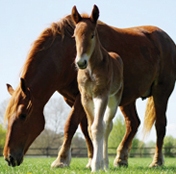Suffolk is the proud birthplace of the Suffolk Punch – a large, strong breed of draught horse intended for strenuous tasks such as cart-pulling and farm labour. This breed’s big and sturdy appearance is where the ‘Punch’ part of its name comes from – these horses really pack a punch! Despite being a highly popular breed of work horse, their numbers have decreased drastically over the last century, so much so that they are now considered one of the rarest breeds in England. Please continuing reading for a detailed description of the Suffolk Punch’s appearance and characteristics, as well an outline of their history to the present day.
Suffolk Punch Horses
Appearance and Characteristics of the Suffolk Punch Horses
As well as being powerful and muscular in appearance, the Suffolk Punch is always chestnut in colour (ranging from dark to light shades of red) with minimal white markings generally found on the head and legs.
The Suffolk Punch tends to be shorter but more strapping than other British draught horses, such as the Clydesdale or the Shire, due to its squat yet thickset legs. It generally stands 16.1 to 17.2 hands tall (65 to 70 inches/165 to 178 CM), and weighs 1,980 to 2,200 pounds (900 to 1,000 kg) – however, it is very energetic and nimble for a horse of its physique. It has a strong, arching neck and powerful, sloping shoulders atop a broad back and rump.
It was once the case that the Suffolk Punch had hooves that were too small when compared to its body mass. This was corrected by the introduction of classes at major shows in which hoof conformation and structure were judged, and today it is considered to have excellent foot conformation with well formed hooves. There is very little or no feathering on its fetlocks by the ankles.
As well as being incredibly strong, the Suffolk Punch is a lively horse despite its bulky appearance, and is fast at a trot with masses of stamina. It is also thought to have a mild, docile temperament, making them wonderful companions.
The breed tends to mature early and live a long life. Unusually, it needs less food than other draught horses, so is economical to keep. Other breeds were cross-bred in an attempt to increase the height of the Suffolk Punch but with little effect, and the breed remains much as it was before any cross-breeding took place.
Suffolk Punch Horses
History of Suffolk Punch Horses
The Suffolk Punch – also known as the Suffolk Horse or Suffolk Sorrel – is the oldest breed of English work horse to exist in a form which is recognised today. The breed can be traced back to a stallion foaled near Woodbridge in 1768. This horse was owned by Thomas Crisp of Ufford and simply known as ‘Crisp’s horse’. However, this was not the first Suffolk Punch to have been bred but is commonly mistaken as such. The reason for this is that, by the 1760s, all other male lines of the breed had died out. The event when a species dies out and is thus prevented from reproducing is called a genetic ‘bottleneck’, and a second bottleneck occurred for the Suffolk Punch in the late 18th Century.
The Suffolk Horse Society, formed in Britain in 1877 to promote the Suffolk Punch, and in the mid-to-late 19th century, the Suffolk Punch began to be exported all over the world. The first official exports to Canada took place in 1865. Punches were exported to the United States in 1880, with more following in 1888, and in 1903 they began being bred there. The American Suffolk Horse Association was established in 1907. By 1908, the Suffolk had also been exported to Spain, France, Germany, Austria, Russia, Sweden, various parts of Africa, New Zealand, Australia, Argentina, plus a number of other countries, thus making it a worldwide favorite working horse.
The Suffolk Punch was one of the most popular work horses in East Anglia throughout the First World War, and it remained so until the Second World War when farm work became more mechanical and the need for work horses decimated. After WW2, the Suffolk Horse Society had only a mere nine foals registered and the American Suffolk Horse Association became inactive. However, there was a revival in the late 1960s, and the American Suffolk Horse Association restarted in May 1961 as the draught horse market began to recover, yet the breed remained rare. In 1998 there were only 80 breeding mares in Britain, producing around 40 foals per year.
Suffolk Punch Horses
Although the Suffolk Punch population has continued to increase, both the Rare Breeds Survival Trust in the UK and the American Livestock Breeds Conservancy consider their survival status to be critical and as of 2001, the breed was considered the rarest horse breed in Britain. Throughout the early 21st Century, births of pure-bred foals ranged from 30-40 per year in Britain.
The breed has a special place in Suffolk’s history and in its people’s hearts. It is still recognised as an icon for the County and as a highly important feature of the countryside heritage.

Please also see:
Horse Riding in Suffolk
Do you know something interesting about Suffolk Punches? Please share it with us at [email protected]!

